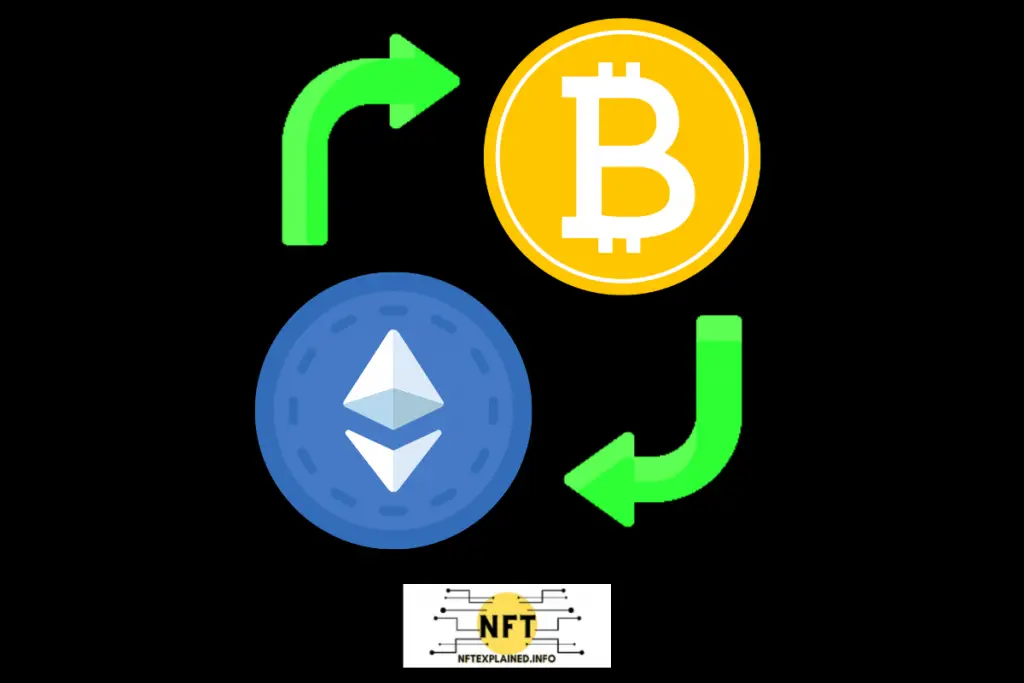
Converting or swapping cryptocurrency can be thought of as exchanging one currency for another; an example is exchanging USD for Euros. In this guide our team will explain how this process works, share our personal experience converting cryptocurrencies on a range of different platforms and more. So, what does it mean to convert/swap cryptocurrencies?
Converting or swapping cryptocurrencies is the process of exchanging one crypto for another (e.g. BTC to ETH and vice versa). This can be done through centralized crypto exchanges or decentralized crypto exchanges; both ways incur transaction fees, with the fee amount depending on numerous factors.
This process involves transferring funds from one cryptocurrency wallet (eg. a Bitcoin wallet) to an another cryptocurrency wallet (eg. an Ethereum wallet); converting/swapping is done on a single account, in almost all cases (like on centralized exchanges), so you won’t have to worry about inputting your correct and specific cryptocurrency wallet.
If you are doing this on platforms like Coinbase, Binance and even MetaMask, you will not have to worry about creating a specific wallet for a given cryptocurrency. This process simply involves clicking swap and inputting the two currencies you are looking to exchange.
You will realize that the second cryptocurrency is the one that will fund the fees. For example, if you exchange Bitcoin for Ethereum, you will lose a small amount of Ethereum in the transaction.
What Platform Is The Best For Converting/Swapping Crypto?
Swapping or converting cryptocurrencies on centralized exchanges like Binance or Coinbase incur remarkably similar fees. We paid 5 cents swapping $1 BTC to $1 ETH on Binance and 3 cents on Coinbase. Using MetaMask, a decentralized exchange, the same trade incurred $1.90 in gas fees.
Please complete your own due diligence. Our team would recommend swapping on centralized exchanges but keeping your funds on a hardware wallet, where you have full custody of the asset, and not the exchange.
If you are looking to swap crypto, and you do so on a centralized exchange, we would highly recommend transferring the funds to your hardware wallet after the process completes.
A safer option would be to swap or convert crypto on your hardware wallet itself; for example, all Ledger products use Changelly, which is decentralized. That being said, all transactions on Changelly are likely to incur a slightly higher transaction fee because miners need to verify the transaction. More on miners verifying transactions in the following paragraphs.
The amount of fees incurred for both centralized and decentralized exchanges depend on a range of factors including the number of people looking to make a transaction at that given time and the amount of liquidity available. For example, Coinbase stated, “Fees are calculated at the time you place your order and may be determined by a combination of factors, including but not limited to your location, the selected payment method, the size of the order, and market conditions such as volatility and liquidity.”
Binance stated, “Trading fees are determined by your 30-day trading volume*, calculated on a rolling basis every day at 8 p.m. EDT.”
MetaMask stated, “Swaps ensures that you always have access to the largest selection of tokens and the most competitive prices, by providing prices from multiple aggregators and individual market makers in one place. A service fee of 0.875% is automatically factored into each quote, which supports ongoing development to make MetaMask even better.”
On decentralized exchanges, miners are the ones verifying transactions. Miners are nodes that are running a given blockchain code and ensure that all transactions are valid to occur. In this case miners are verifying the smart contract for the conversion of a cryptocurrency and are rewarded for doing so.
Smart contracts are how converting crypto is completed on decentralized exchanges; smart contracts can be thought of as autonomous code that executes when the buyer and seller agree to the terms.
How To Convert/Swap Crypto On Ledger Hardware Wallets?
Most hardware wallets have a built in feature that allows you to swap cryptocurrencies for one another. Our team has done this on numerous Ledger products as each Ledger provides the same user interface.
So how do you swap crypto on a Ledger?
Swapping crypto on a Ledger involves two steps. The first is installing the cryptocurrency applications (eg. a Bitcoin wallet & Ethereum wallet if you are looking to swap the two). The second step is installing the “Exchange” app on the Ledger interface. After, simply enter the amounts and hit swap.
Again, this process is facilitated through Changelly, a decentralized exchange. More on this process can be found in Ledger’s YouTube video linked here.
Why Would Someone Convert/Swap Cryptocurrencies?
People typically convert one cryptocurrency into another because they believe that the converted cryptocurrency will appreciate in value more than the other. Others swap/convert to diversify their portfolio or to gain access to the utility that a cryptocurrency may offer.
Another primary reason that people convert or swap cryptocurrencies is because they may not want to invest more funds into crypto but rather play around or rearrange their portfolio through swapping.
Let our team know what you think about swapping crypto by connecting with us on Instagram, Twitter & TikTok! As well as subscribe to our YouTube!
Additionally, please consider supporting our team’s content creation through doing business with our partners: Trade stocks & crypto on Webull – get 2 free stocks. Buy a Ledger hardware wallet. U.S. users can get a crypto trading discount on Binance!
